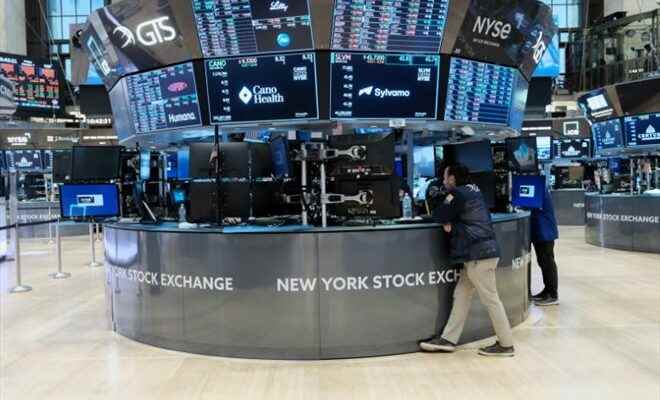The floor of the New York Stock Exchange (GETTY IMAGES NORTH AMERICA/AFP/SPENCER PLATT)
The New York Stock Exchange opened in dispersed order on Wednesday after retail sales in progress, but lackluster results from the side of large distributors.
Around 3:20 p.m. GMT, the Dow Jones index gleaned 0.03%, the technology-dominated Nasdaq lost 1.46% and the S&P 500 0.58%.
The day before, after a slowing producer price index, the Dow Jones had gained 0.17% to 33,592.92 points, the Nasdaq index had gained 1.45% to 11,358.41 points and the broader S&P 500 index had advanced by 0.87% to 3,991.73 points.
“The session begins without much conviction”, noted Patrick O’Hare of Briefing.com.
Among the positive news retail sales rose at a faster pace than expected in October at +1.3% against +1.2% expected.
But this increase is notably attributable to the return of an increase in gasoline prices at the pump which pushed up service station sales by 4.1% over the month.
Patrick O’Hare also pointed out that this report on Americans’ purchases of goods reflected contradictory trends. While online sales (+1.2%) and those of bars and restaurants (+1.6%) experienced a solid increase, many categories of discretionary purchases were down, showing that households are being parsimonious in their consumption. This was the case for sales of electronics and household appliances (-0.3%) and leisure items (also -0.3%).
At the distributor level, the Target department store chain recorded weaker than expected quarterly profits and the brand revised down its sales targets for the end of the year holidays. Target also said it has a cost reduction plan over the next three years.
The action suffered the blow losing almost 15%, while other chain titles followed such as Best Buy, an electronics specialist (-7.69%) or Home Depot, the DIY equipment chain (- 0.85%).
Lowe’s stores, devoted to home improvement, fared better (+4.55%) after quarterly profit and better-than-expected sales.
Among the macroeconomic news that depressed the indices, US industrial production fell slightly in October (-0.1%) and that of September was revised sharply downwards.
“Weakening demand, rising interest rates and supply chain difficulties will continue to weigh on industrial activity in the months to come,” said Nancy Vanden Houten, economist for Oxford Economics.
“The strength of retail sales despite higher borrowing costs is encouraging, but manufacturing activity is slowing slowly succumbing to general malaise,” said Paul Ashworth of Capital Economics.
UK inflation soared to 11.1% YoY in October, a new 41-year high, driven by a further rise in energy costs.
In China, the price of new homes fell in October, the largest decline in seven years, according to official figures released Wednesday, against a backdrop of economic slowdown and housing crisis.
On the bond market, yields on 10-year Treasury bills fell from 1.78% to 3.73%.
The cryptocurrency sector slipped in the wake of the bankrupt platform FTX, Coinbase lost almost 10%, the brokerage application Robinhood dropped 3.53% while bitcoin lost 2.45%.
© 2022 AFP
Did you like this article ? Share it with your friends with the buttons below.




